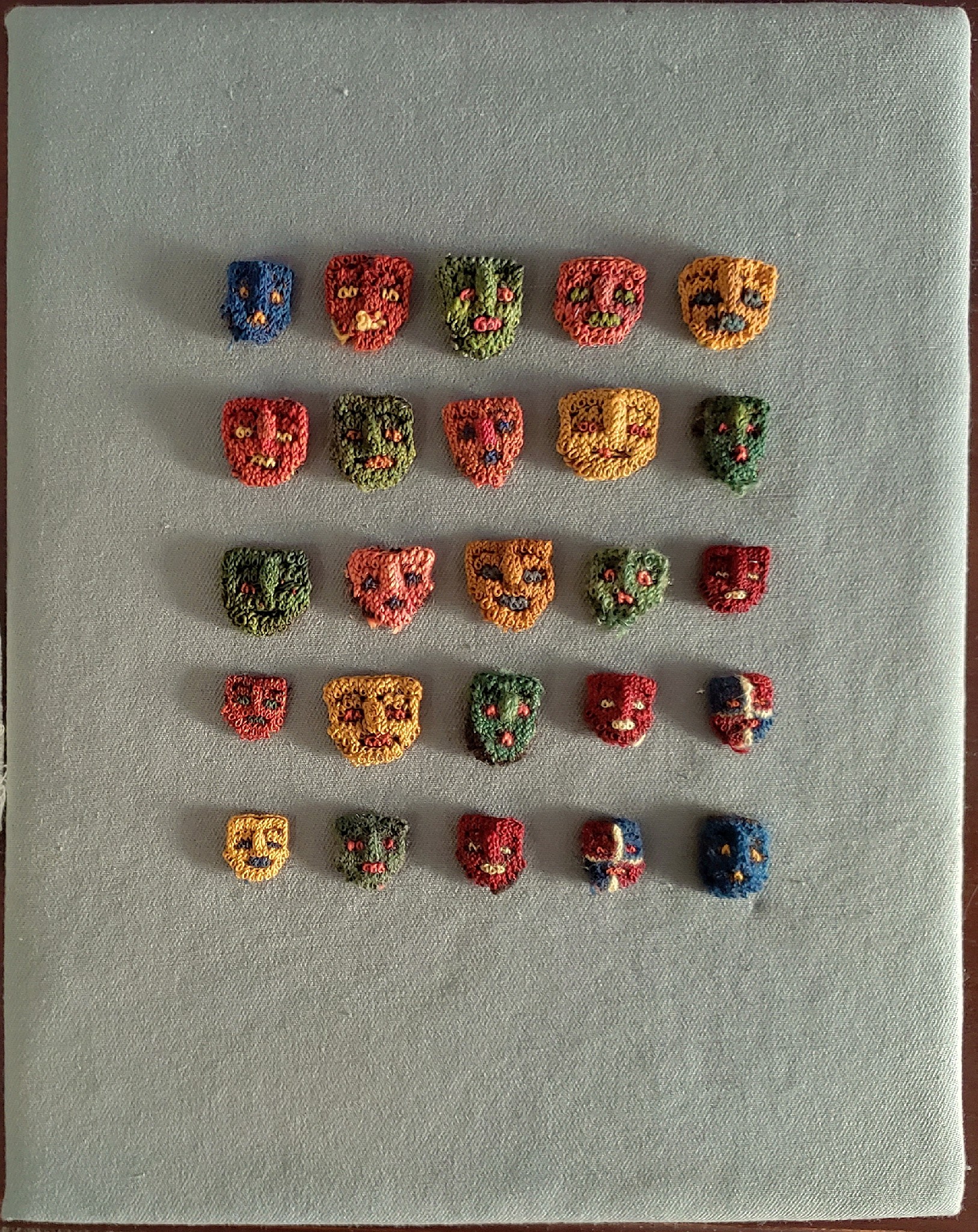


Peru, 25 Proto-Nasca Knitted Miniature Faces in Blue, Green, Pink, Red and Yellow
The faces were from a fancy fringe, made using the cross-loop needle stitch. Each face has two or more colors. They may have represented trophy heads, or perhaps were used as totems guard against evil spirits. Houston private collection, prior to 1980.
Period: Peru, Proto-Nasca, South Coast, c. 100 BC - AD 200
Media: Textile
Dimensions: Mounted in a shadow Box 10" x 11"
$1,500
p2039

Peru, Early Nasca Gold Pair of Earrings with Filigree Decoration
A matched set of Nasca gold earrings with true filigree work and original archaeological patina. The wire is skillfully soldered to the central disc.
Period: Peru, Nasca, South Coast, c. AD 400 - 800
Media: Metal
Dimensions: Width 1 3/8" Weight: 3.8 grams
Price Upon Request
87044













Peru, Early Nazca/Late Wari Tie- Dye Patchwork Rectangular Bag
This tie dye rectangular bag with discontinuous interlocking patchwork was probably used for carrying feathers. The bag was made from surplus squares left over from a larger mantle, utilizing the scaffold technique. Collected by Gunnolf Bjorkman who worked in Lima in the 1960's and settled in Buenos Aires.
Period: Peru, Nasca, South Coast, c. AD 300 - 700
Media: Textile
Dimensions: Length: 26" x Width: 4 1/2 in.
$7,250
91265
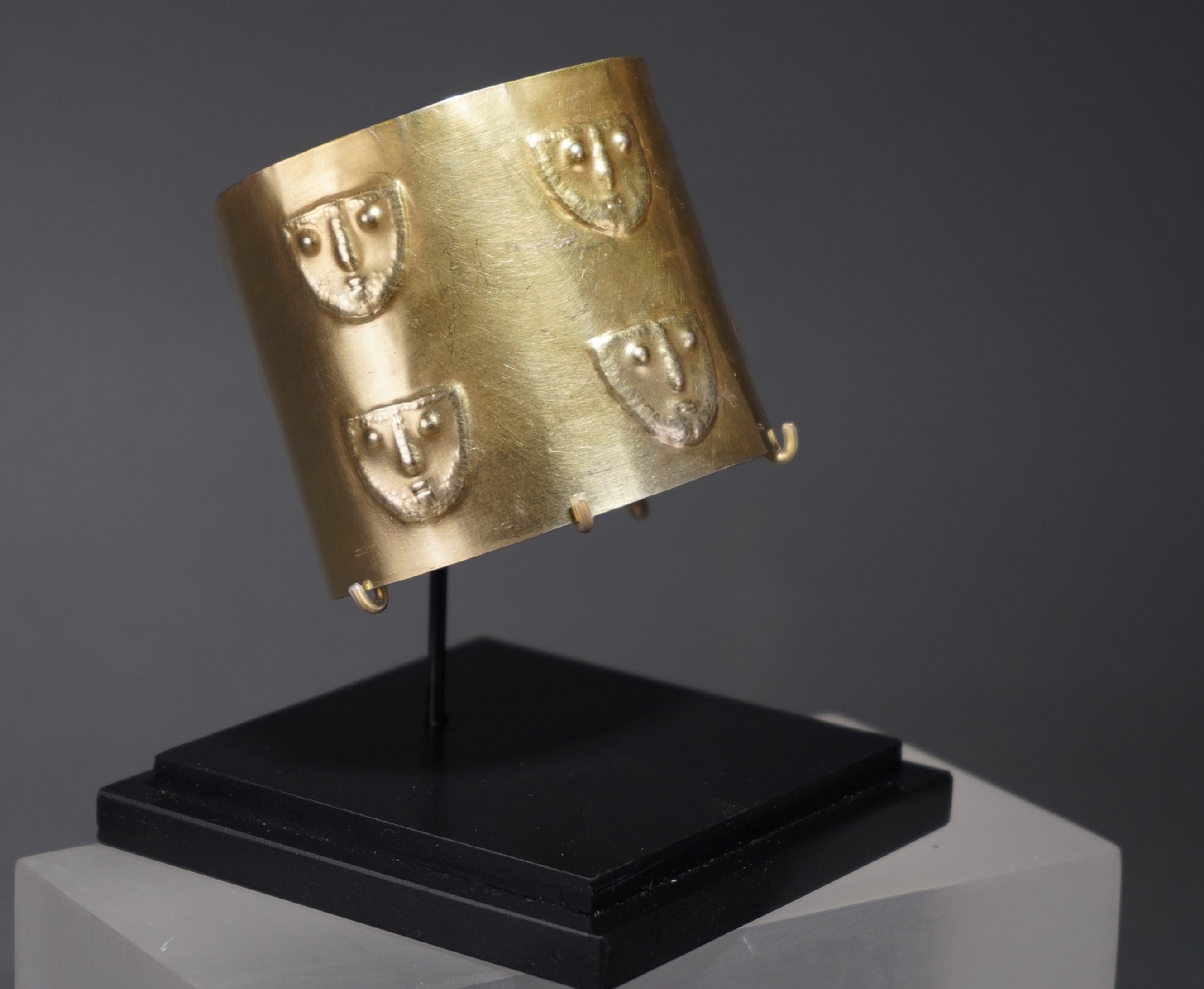





Peru, Late Nasca Gold Cuff with Embossed Faces
A hammered and repousse gold cuff decorated with two rows of faces, probably representing masks. I have not seen many cuffs embossed, as most Late Nasca art consists of simple wrought gold, occasionally with a geometric pattern. These embossed masks are quite rare. There are two tie holes on each edge of the cuff. Similar Nasca gold cuffs are illustrated in the THE GOLD OF PERU, MUJICA GAILLO COLLECTION. Ex-Collection Jean Eugene Lions, St. Tropez, since 1970.
Period: Peru, Nasca, South Coast, c. AD 400 - 800
Media: Metal
Dimensions: Height 2 1/4' Weight 40 grams
Alloy: Au.32.7, Ag. 55.3 & Cu.11.6 = 99.6%
$6,750
M5078
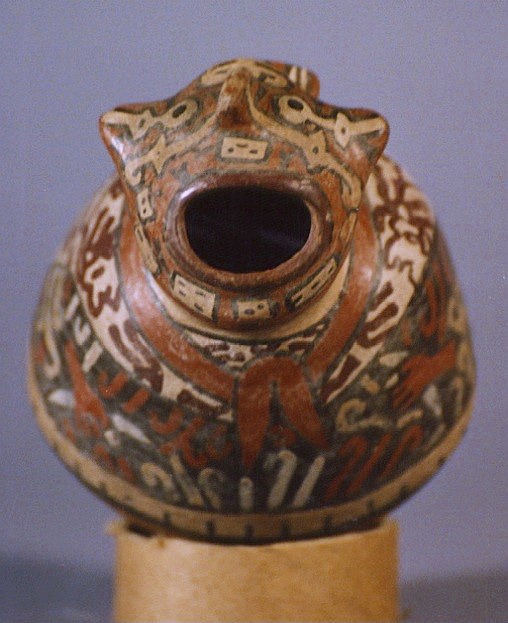







Peru, Late Nazca Ceramic Vessel in the form of a Howling Man
A very delicately modeled and painted miniature vessel of a howling man. The face can be read upside-down as well. Seen from right-side up, the figure appears to be wearing a tunic and cape decorated with abstract heads. From upside-down the tunic turns into a scarf, and the cape becomes the tunic. The face also changes according to the direction the object is seen from. The howling image is associated with decapitation and the trophy head ritual.
Period: Peru, Late Nasca drainage, South Coast, c. AD 600 - 800
Media: Ceramic
Dimensions: Height: 4 1/4"
Price Upon Request
92037













Peru, Late Paracas Needlework Border with Hummingbirds and Cactus Flowers
The border is composed of cross loop needle-knitted hummingbirds sucking the nectar from flowering cacti in alternating color arrangements. There are ten basic colors with additional tones to include blues, grays, greens, gold, pinks, purples, reds, tans and whites. Each bird's head has a long beak, different colored eyes, a slender body, and a wide tail. The cacti are made in five parts, from the upper flower to the lower flower’s broad cactus leaves. The Nasca people are considered to have the most colorful costumes in all antiquity. Their richly colored weavings are often perfectly preserved, having been buried in the driest dessert in the world. Nasca borders and fringes would surround an entire mantle or tunic, which could be many yards in length. The Metropolitan Museum of Art has only two short segments depicting hummingbirds. The Textile Museum in Washington, D.C. has a similar border that is only 21†in length, which is illustrated in EARLY NASCA NEEDLEWORK by Alan Sawyer, image 116. Other early Nasca needle knit birds are in the Met Museum. Formerly in the collection of Justin Kerr, New York, prior to 1970.
Period: Peru, Paracas, South Coast, c. 200 - 100 BC
Media: Textile
Dimensions: Length 40" x Height 3"
Frame dimensions: Length 42" x Height: 9"
Price Upon Request
n7035
![Peru, Late Paracas/Early Nasca Embroidered Section with Four Colorful Monkey Deities in Alternating Colors on a Gold Ground
This textile portrays a series of ecstatic shamans as Animal Impersonators. The main figures, depicted with flying wings, are referred to as monkey deities because they have opposing toes. The bright, abstract color combinations not normally found in nature and the dense shamanic imagery such as double-headed serpents, flint knives, and trophy heads, could easily have been the result of a psychedelic journey. Note: Psychiatrist Oscar Janiger’s studies in the 1950s revealed that that LSD “not only radically changed the [artist’s] style but also gave them new depths to understand the use of color, form, light, or the way these things are viewed in a frame of reference.†(Dobkin/Janiger, 2003, p.80]. The beautifully contrasting colors, and the fluidity of the figure-ground relationship of this Paracas textile connotes a psychedelic influence on the ancient Paracas and Nasca people -possibly that of psilocybin. Shamanic animal transformation in Andean art represents the journey to the afterlife by way of psychic flight.
From top to bottom: The top figure wears a grey puma headdress with Chile peppers, a white nose ornament, and a tunic with a step volute border. Serpents with suspended kidney beans flank him on both sides, and another serpent emanates from his mouth. The second wears a diadem on his forehead, a cloak, and a loin cloth, and is surrounded by three animal heads. He wears a gold mask with a serpent emanating from his mouth and holds a trophy head in one hand and a flint knife in the other. The following figure repeats the compositional structure of the first figure but has a completely different color arrangement. The last figure repeats the structure of the second figure, also in completely different colors. No two figures are the same, and the curvature of the snakes created in alternating colors conveys a sense of motion. Another section from the same textile is in the Israel Museum, Jerusalem. Period: Peru, Paracas-Ocucaje 10, or Nasca 1, South Coast, c. BC 100 - AD 100
Period: Peru, Paracas-Ocucaje 10, or Nasca 1, South Coast, c. BC 100 - AD 100
Media: Textile
Dimensions: Textile, Length: 24" x Width: 2 3/4" Plexiglas frame, Length: 27"x Width: 5 1/2"
Price Upon Request
pp008](/images/16081_h2048w2048gt.5.jpg)
![Peru, Late Paracas/Early Nasca Embroidered Section with Four Colorful Monkey Deities in Alternating Colors on a Gold Ground
This textile portrays a series of ecstatic shamans as Animal Impersonators. The main figures, depicted with flying wings, are referred to as monkey deities because they have opposing toes. The bright, abstract color combinations not normally found in nature and the dense shamanic imagery such as double-headed serpents, flint knives, and trophy heads, could easily have been the result of a psychedelic journey. Note: Psychiatrist Oscar Janiger’s studies in the 1950s revealed that that LSD “not only radically changed the [artist’s] style but also gave them new depths to understand the use of color, form, light, or the way these things are viewed in a frame of reference.†(Dobkin/Janiger, 2003, p.80]. The beautifully contrasting colors, and the fluidity of the figure-ground relationship of this Paracas textile connotes a psychedelic influence on the ancient Paracas and Nasca people -possibly that of psilocybin. Shamanic animal transformation in Andean art represents the journey to the afterlife by way of psychic flight.
From top to bottom: The top figure wears a grey puma headdress with Chile peppers, a white nose ornament, and a tunic with a step volute border. Serpents with suspended kidney beans flank him on both sides, and another serpent emanates from his mouth. The second wears a diadem on his forehead, a cloak, and a loin cloth, and is surrounded by three animal heads. He wears a gold mask with a serpent emanating from his mouth and holds a trophy head in one hand and a flint knife in the other. The following figure repeats the compositional structure of the first figure but has a completely different color arrangement. The last figure repeats the structure of the second figure, also in completely different colors. No two figures are the same, and the curvature of the snakes created in alternating colors conveys a sense of motion. Another section from the same textile is in the Israel Museum, Jerusalem. Period: Peru, Paracas-Ocucaje 10, or Nasca 1, South Coast, c. BC 100 - AD 100
Period: Peru, Paracas-Ocucaje 10, or Nasca 1, South Coast, c. BC 100 - AD 100
Media: Textile
Dimensions: Textile, Length: 24" x Width: 2 3/4" Plexiglas frame, Length: 27"x Width: 5 1/2"
Price Upon Request
pp008](/images/16081_h100w100gt.5.jpg)
![Peru, Late Paracas/Early Nasca Embroidered Section with Four Colorful Monkey Deities in Alternating Colors on a Gold Ground
This textile portrays a series of ecstatic shamans as Animal Impersonators. The main figures, depicted with flying wings, are referred to as monkey deities because they have opposing toes. The bright, abstract color combinations not normally found in nature and the dense shamanic imagery such as double-headed serpents, flint knives, and trophy heads, could easily have been the result of a psychedelic journey. Note: Psychiatrist Oscar Janiger’s studies in the 1950s revealed that that LSD “not only radically changed the [artist’s] style but also gave them new depths to understand the use of color, form, light, or the way these things are viewed in a frame of reference.†(Dobkin/Janiger, 2003, p.80]. The beautifully contrasting colors, and the fluidity of the figure-ground relationship of this Paracas textile connotes a psychedelic influence on the ancient Paracas and Nasca people -possibly that of psilocybin. Shamanic animal transformation in Andean art represents the journey to the afterlife by way of psychic flight.
From top to bottom: The top figure wears a grey puma headdress with Chile peppers, a white nose ornament, and a tunic with a step volute border. Serpents with suspended kidney beans flank him on both sides, and another serpent emanates from his mouth. The second wears a diadem on his forehead, a cloak, and a loin cloth, and is surrounded by three animal heads. He wears a gold mask with a serpent emanating from his mouth and holds a trophy head in one hand and a flint knife in the other. The following figure repeats the compositional structure of the first figure but has a completely different color arrangement. The last figure repeats the structure of the second figure, also in completely different colors. No two figures are the same, and the curvature of the snakes created in alternating colors conveys a sense of motion. Another section from the same textile is in the Israel Museum, Jerusalem. Period: Peru, Paracas-Ocucaje 10, or Nasca 1, South Coast, c. BC 100 - AD 100
Period: Peru, Paracas-Ocucaje 10, or Nasca 1, South Coast, c. BC 100 - AD 100
Media: Textile
Dimensions: Textile, Length: 24" x Width: 2 3/4" Plexiglas frame, Length: 27"x Width: 5 1/2"
Price Upon Request
pp008](/images/16082_h100w100gt.5.jpg)
![Peru, Late Paracas/Early Nasca Embroidered Section with Four Colorful Monkey Deities in Alternating Colors on a Gold Ground
This textile portrays a series of ecstatic shamans as Animal Impersonators. The main figures, depicted with flying wings, are referred to as monkey deities because they have opposing toes. The bright, abstract color combinations not normally found in nature and the dense shamanic imagery such as double-headed serpents, flint knives, and trophy heads, could easily have been the result of a psychedelic journey. Note: Psychiatrist Oscar Janiger’s studies in the 1950s revealed that that LSD “not only radically changed the [artist’s] style but also gave them new depths to understand the use of color, form, light, or the way these things are viewed in a frame of reference.†(Dobkin/Janiger, 2003, p.80]. The beautifully contrasting colors, and the fluidity of the figure-ground relationship of this Paracas textile connotes a psychedelic influence on the ancient Paracas and Nasca people -possibly that of psilocybin. Shamanic animal transformation in Andean art represents the journey to the afterlife by way of psychic flight.
From top to bottom: The top figure wears a grey puma headdress with Chile peppers, a white nose ornament, and a tunic with a step volute border. Serpents with suspended kidney beans flank him on both sides, and another serpent emanates from his mouth. The second wears a diadem on his forehead, a cloak, and a loin cloth, and is surrounded by three animal heads. He wears a gold mask with a serpent emanating from his mouth and holds a trophy head in one hand and a flint knife in the other. The following figure repeats the compositional structure of the first figure but has a completely different color arrangement. The last figure repeats the structure of the second figure, also in completely different colors. No two figures are the same, and the curvature of the snakes created in alternating colors conveys a sense of motion. Another section from the same textile is in the Israel Museum, Jerusalem. Period: Peru, Paracas-Ocucaje 10, or Nasca 1, South Coast, c. BC 100 - AD 100
Period: Peru, Paracas-Ocucaje 10, or Nasca 1, South Coast, c. BC 100 - AD 100
Media: Textile
Dimensions: Textile, Length: 24" x Width: 2 3/4" Plexiglas frame, Length: 27"x Width: 5 1/2"
Price Upon Request
pp008](/images/16085_h100w100gt.5.jpg)
![Peru, Late Paracas/Early Nasca Embroidered Section with Four Colorful Monkey Deities in Alternating Colors on a Gold Ground
This textile portrays a series of ecstatic shamans as Animal Impersonators. The main figures, depicted with flying wings, are referred to as monkey deities because they have opposing toes. The bright, abstract color combinations not normally found in nature and the dense shamanic imagery such as double-headed serpents, flint knives, and trophy heads, could easily have been the result of a psychedelic journey. Note: Psychiatrist Oscar Janiger’s studies in the 1950s revealed that that LSD “not only radically changed the [artist’s] style but also gave them new depths to understand the use of color, form, light, or the way these things are viewed in a frame of reference.†(Dobkin/Janiger, 2003, p.80]. The beautifully contrasting colors, and the fluidity of the figure-ground relationship of this Paracas textile connotes a psychedelic influence on the ancient Paracas and Nasca people -possibly that of psilocybin. Shamanic animal transformation in Andean art represents the journey to the afterlife by way of psychic flight.
From top to bottom: The top figure wears a grey puma headdress with Chile peppers, a white nose ornament, and a tunic with a step volute border. Serpents with suspended kidney beans flank him on both sides, and another serpent emanates from his mouth. The second wears a diadem on his forehead, a cloak, and a loin cloth, and is surrounded by three animal heads. He wears a gold mask with a serpent emanating from his mouth and holds a trophy head in one hand and a flint knife in the other. The following figure repeats the compositional structure of the first figure but has a completely different color arrangement. The last figure repeats the structure of the second figure, also in completely different colors. No two figures are the same, and the curvature of the snakes created in alternating colors conveys a sense of motion. Another section from the same textile is in the Israel Museum, Jerusalem. Period: Peru, Paracas-Ocucaje 10, or Nasca 1, South Coast, c. BC 100 - AD 100
Period: Peru, Paracas-Ocucaje 10, or Nasca 1, South Coast, c. BC 100 - AD 100
Media: Textile
Dimensions: Textile, Length: 24" x Width: 2 3/4" Plexiglas frame, Length: 27"x Width: 5 1/2"
Price Upon Request
pp008](/images/15195_h100w100gt.5.jpg)
![Peru, Late Paracas/Early Nasca Embroidered Section with Four Colorful Monkey Deities in Alternating Colors on a Gold Ground
This textile portrays a series of ecstatic shamans as Animal Impersonators. The main figures, depicted with flying wings, are referred to as monkey deities because they have opposing toes. The bright, abstract color combinations not normally found in nature and the dense shamanic imagery such as double-headed serpents, flint knives, and trophy heads, could easily have been the result of a psychedelic journey. Note: Psychiatrist Oscar Janiger’s studies in the 1950s revealed that that LSD “not only radically changed the [artist’s] style but also gave them new depths to understand the use of color, form, light, or the way these things are viewed in a frame of reference.†(Dobkin/Janiger, 2003, p.80]. The beautifully contrasting colors, and the fluidity of the figure-ground relationship of this Paracas textile connotes a psychedelic influence on the ancient Paracas and Nasca people -possibly that of psilocybin. Shamanic animal transformation in Andean art represents the journey to the afterlife by way of psychic flight.
From top to bottom: The top figure wears a grey puma headdress with Chile peppers, a white nose ornament, and a tunic with a step volute border. Serpents with suspended kidney beans flank him on both sides, and another serpent emanates from his mouth. The second wears a diadem on his forehead, a cloak, and a loin cloth, and is surrounded by three animal heads. He wears a gold mask with a serpent emanating from his mouth and holds a trophy head in one hand and a flint knife in the other. The following figure repeats the compositional structure of the first figure but has a completely different color arrangement. The last figure repeats the structure of the second figure, also in completely different colors. No two figures are the same, and the curvature of the snakes created in alternating colors conveys a sense of motion. Another section from the same textile is in the Israel Museum, Jerusalem. Period: Peru, Paracas-Ocucaje 10, or Nasca 1, South Coast, c. BC 100 - AD 100
Period: Peru, Paracas-Ocucaje 10, or Nasca 1, South Coast, c. BC 100 - AD 100
Media: Textile
Dimensions: Textile, Length: 24" x Width: 2 3/4" Plexiglas frame, Length: 27"x Width: 5 1/2"
Price Upon Request
pp008](/images/15197_h100w100gt.5.jpg)
![Peru, Late Paracas/Early Nasca Embroidered Section with Four Colorful Monkey Deities in Alternating Colors on a Gold Ground
This textile portrays a series of ecstatic shamans as Animal Impersonators. The main figures, depicted with flying wings, are referred to as monkey deities because they have opposing toes. The bright, abstract color combinations not normally found in nature and the dense shamanic imagery such as double-headed serpents, flint knives, and trophy heads, could easily have been the result of a psychedelic journey. Note: Psychiatrist Oscar Janiger’s studies in the 1950s revealed that that LSD “not only radically changed the [artist’s] style but also gave them new depths to understand the use of color, form, light, or the way these things are viewed in a frame of reference.†(Dobkin/Janiger, 2003, p.80]. The beautifully contrasting colors, and the fluidity of the figure-ground relationship of this Paracas textile connotes a psychedelic influence on the ancient Paracas and Nasca people -possibly that of psilocybin. Shamanic animal transformation in Andean art represents the journey to the afterlife by way of psychic flight.
From top to bottom: The top figure wears a grey puma headdress with Chile peppers, a white nose ornament, and a tunic with a step volute border. Serpents with suspended kidney beans flank him on both sides, and another serpent emanates from his mouth. The second wears a diadem on his forehead, a cloak, and a loin cloth, and is surrounded by three animal heads. He wears a gold mask with a serpent emanating from his mouth and holds a trophy head in one hand and a flint knife in the other. The following figure repeats the compositional structure of the first figure but has a completely different color arrangement. The last figure repeats the structure of the second figure, also in completely different colors. No two figures are the same, and the curvature of the snakes created in alternating colors conveys a sense of motion. Another section from the same textile is in the Israel Museum, Jerusalem. Period: Peru, Paracas-Ocucaje 10, or Nasca 1, South Coast, c. BC 100 - AD 100
Period: Peru, Paracas-Ocucaje 10, or Nasca 1, South Coast, c. BC 100 - AD 100
Media: Textile
Dimensions: Textile, Length: 24" x Width: 2 3/4" Plexiglas frame, Length: 27"x Width: 5 1/2"
Price Upon Request
pp008](/images/16084_h100w100gt.5.jpg)
![Peru, Late Paracas/Early Nasca Embroidered Section with Four Colorful Monkey Deities in Alternating Colors on a Gold Ground
This textile portrays a series of ecstatic shamans as Animal Impersonators. The main figures, depicted with flying wings, are referred to as monkey deities because they have opposing toes. The bright, abstract color combinations not normally found in nature and the dense shamanic imagery such as double-headed serpents, flint knives, and trophy heads, could easily have been the result of a psychedelic journey. Note: Psychiatrist Oscar Janiger’s studies in the 1950s revealed that that LSD “not only radically changed the [artist’s] style but also gave them new depths to understand the use of color, form, light, or the way these things are viewed in a frame of reference.†(Dobkin/Janiger, 2003, p.80]. The beautifully contrasting colors, and the fluidity of the figure-ground relationship of this Paracas textile connotes a psychedelic influence on the ancient Paracas and Nasca people -possibly that of psilocybin. Shamanic animal transformation in Andean art represents the journey to the afterlife by way of psychic flight.
From top to bottom: The top figure wears a grey puma headdress with Chile peppers, a white nose ornament, and a tunic with a step volute border. Serpents with suspended kidney beans flank him on both sides, and another serpent emanates from his mouth. The second wears a diadem on his forehead, a cloak, and a loin cloth, and is surrounded by three animal heads. He wears a gold mask with a serpent emanating from his mouth and holds a trophy head in one hand and a flint knife in the other. The following figure repeats the compositional structure of the first figure but has a completely different color arrangement. The last figure repeats the structure of the second figure, also in completely different colors. No two figures are the same, and the curvature of the snakes created in alternating colors conveys a sense of motion. Another section from the same textile is in the Israel Museum, Jerusalem. Period: Peru, Paracas-Ocucaje 10, or Nasca 1, South Coast, c. BC 100 - AD 100
Period: Peru, Paracas-Ocucaje 10, or Nasca 1, South Coast, c. BC 100 - AD 100
Media: Textile
Dimensions: Textile, Length: 24" x Width: 2 3/4" Plexiglas frame, Length: 27"x Width: 5 1/2"
Price Upon Request
pp008](/images/15198_h100w100gt.5.jpg)
![Peru, Late Paracas/Early Nasca Embroidered Section with Four Colorful Monkey Deities in Alternating Colors on a Gold Ground
This textile portrays a series of ecstatic shamans as Animal Impersonators. The main figures, depicted with flying wings, are referred to as monkey deities because they have opposing toes. The bright, abstract color combinations not normally found in nature and the dense shamanic imagery such as double-headed serpents, flint knives, and trophy heads, could easily have been the result of a psychedelic journey. Note: Psychiatrist Oscar Janiger’s studies in the 1950s revealed that that LSD “not only radically changed the [artist’s] style but also gave them new depths to understand the use of color, form, light, or the way these things are viewed in a frame of reference.†(Dobkin/Janiger, 2003, p.80]. The beautifully contrasting colors, and the fluidity of the figure-ground relationship of this Paracas textile connotes a psychedelic influence on the ancient Paracas and Nasca people -possibly that of psilocybin. Shamanic animal transformation in Andean art represents the journey to the afterlife by way of psychic flight.
From top to bottom: The top figure wears a grey puma headdress with Chile peppers, a white nose ornament, and a tunic with a step volute border. Serpents with suspended kidney beans flank him on both sides, and another serpent emanates from his mouth. The second wears a diadem on his forehead, a cloak, and a loin cloth, and is surrounded by three animal heads. He wears a gold mask with a serpent emanating from his mouth and holds a trophy head in one hand and a flint knife in the other. The following figure repeats the compositional structure of the first figure but has a completely different color arrangement. The last figure repeats the structure of the second figure, also in completely different colors. No two figures are the same, and the curvature of the snakes created in alternating colors conveys a sense of motion. Another section from the same textile is in the Israel Museum, Jerusalem. Period: Peru, Paracas-Ocucaje 10, or Nasca 1, South Coast, c. BC 100 - AD 100
Period: Peru, Paracas-Ocucaje 10, or Nasca 1, South Coast, c. BC 100 - AD 100
Media: Textile
Dimensions: Textile, Length: 24" x Width: 2 3/4" Plexiglas frame, Length: 27"x Width: 5 1/2"
Price Upon Request
pp008](/images/16086_h100w100gt.5.jpg)
![Peru, Late Paracas/Early Nasca Embroidered Section with Four Colorful Monkey Deities in Alternating Colors on a Gold Ground
This textile portrays a series of ecstatic shamans as Animal Impersonators. The main figures, depicted with flying wings, are referred to as monkey deities because they have opposing toes. The bright, abstract color combinations not normally found in nature and the dense shamanic imagery such as double-headed serpents, flint knives, and trophy heads, could easily have been the result of a psychedelic journey. Note: Psychiatrist Oscar Janiger’s studies in the 1950s revealed that that LSD “not only radically changed the [artist’s] style but also gave them new depths to understand the use of color, form, light, or the way these things are viewed in a frame of reference.†(Dobkin/Janiger, 2003, p.80]. The beautifully contrasting colors, and the fluidity of the figure-ground relationship of this Paracas textile connotes a psychedelic influence on the ancient Paracas and Nasca people -possibly that of psilocybin. Shamanic animal transformation in Andean art represents the journey to the afterlife by way of psychic flight.
From top to bottom: The top figure wears a grey puma headdress with Chile peppers, a white nose ornament, and a tunic with a step volute border. Serpents with suspended kidney beans flank him on both sides, and another serpent emanates from his mouth. The second wears a diadem on his forehead, a cloak, and a loin cloth, and is surrounded by three animal heads. He wears a gold mask with a serpent emanating from his mouth and holds a trophy head in one hand and a flint knife in the other. The following figure repeats the compositional structure of the first figure but has a completely different color arrangement. The last figure repeats the structure of the second figure, also in completely different colors. No two figures are the same, and the curvature of the snakes created in alternating colors conveys a sense of motion. Another section from the same textile is in the Israel Museum, Jerusalem. Period: Peru, Paracas-Ocucaje 10, or Nasca 1, South Coast, c. BC 100 - AD 100
Period: Peru, Paracas-Ocucaje 10, or Nasca 1, South Coast, c. BC 100 - AD 100
Media: Textile
Dimensions: Textile, Length: 24" x Width: 2 3/4" Plexiglas frame, Length: 27"x Width: 5 1/2"
Price Upon Request
pp008](/images/15200_h100w100gt.5.jpg)
![Peru, Late Paracas/Early Nasca Embroidered Section with Four Colorful Monkey Deities in Alternating Colors on a Gold Ground
This textile portrays a series of ecstatic shamans as Animal Impersonators. The main figures, depicted with flying wings, are referred to as monkey deities because they have opposing toes. The bright, abstract color combinations not normally found in nature and the dense shamanic imagery such as double-headed serpents, flint knives, and trophy heads, could easily have been the result of a psychedelic journey. Note: Psychiatrist Oscar Janiger’s studies in the 1950s revealed that that LSD “not only radically changed the [artist’s] style but also gave them new depths to understand the use of color, form, light, or the way these things are viewed in a frame of reference.†(Dobkin/Janiger, 2003, p.80]. The beautifully contrasting colors, and the fluidity of the figure-ground relationship of this Paracas textile connotes a psychedelic influence on the ancient Paracas and Nasca people -possibly that of psilocybin. Shamanic animal transformation in Andean art represents the journey to the afterlife by way of psychic flight.
From top to bottom: The top figure wears a grey puma headdress with Chile peppers, a white nose ornament, and a tunic with a step volute border. Serpents with suspended kidney beans flank him on both sides, and another serpent emanates from his mouth. The second wears a diadem on his forehead, a cloak, and a loin cloth, and is surrounded by three animal heads. He wears a gold mask with a serpent emanating from his mouth and holds a trophy head in one hand and a flint knife in the other. The following figure repeats the compositional structure of the first figure but has a completely different color arrangement. The last figure repeats the structure of the second figure, also in completely different colors. No two figures are the same, and the curvature of the snakes created in alternating colors conveys a sense of motion. Another section from the same textile is in the Israel Museum, Jerusalem. Period: Peru, Paracas-Ocucaje 10, or Nasca 1, South Coast, c. BC 100 - AD 100
Period: Peru, Paracas-Ocucaje 10, or Nasca 1, South Coast, c. BC 100 - AD 100
Media: Textile
Dimensions: Textile, Length: 24" x Width: 2 3/4" Plexiglas frame, Length: 27"x Width: 5 1/2"
Price Upon Request
pp008](/images/15199_h100w100gt.5.jpg)
![Peru, Late Paracas/Early Nasca Embroidered Section with Four Colorful Monkey Deities in Alternating Colors on a Gold Ground
This textile portrays a series of ecstatic shamans as Animal Impersonators. The main figures, depicted with flying wings, are referred to as monkey deities because they have opposing toes. The bright, abstract color combinations not normally found in nature and the dense shamanic imagery such as double-headed serpents, flint knives, and trophy heads, could easily have been the result of a psychedelic journey. Note: Psychiatrist Oscar Janiger’s studies in the 1950s revealed that that LSD “not only radically changed the [artist’s] style but also gave them new depths to understand the use of color, form, light, or the way these things are viewed in a frame of reference.†(Dobkin/Janiger, 2003, p.80]. The beautifully contrasting colors, and the fluidity of the figure-ground relationship of this Paracas textile connotes a psychedelic influence on the ancient Paracas and Nasca people -possibly that of psilocybin. Shamanic animal transformation in Andean art represents the journey to the afterlife by way of psychic flight.
From top to bottom: The top figure wears a grey puma headdress with Chile peppers, a white nose ornament, and a tunic with a step volute border. Serpents with suspended kidney beans flank him on both sides, and another serpent emanates from his mouth. The second wears a diadem on his forehead, a cloak, and a loin cloth, and is surrounded by three animal heads. He wears a gold mask with a serpent emanating from his mouth and holds a trophy head in one hand and a flint knife in the other. The following figure repeats the compositional structure of the first figure but has a completely different color arrangement. The last figure repeats the structure of the second figure, also in completely different colors. No two figures are the same, and the curvature of the snakes created in alternating colors conveys a sense of motion. Another section from the same textile is in the Israel Museum, Jerusalem. Period: Peru, Paracas-Ocucaje 10, or Nasca 1, South Coast, c. BC 100 - AD 100
Period: Peru, Paracas-Ocucaje 10, or Nasca 1, South Coast, c. BC 100 - AD 100
Media: Textile
Dimensions: Textile, Length: 24" x Width: 2 3/4" Plexiglas frame, Length: 27"x Width: 5 1/2"
Price Upon Request
pp008](/images/16083_h100w100gt.5.jpg)
![Peru, Late Paracas/Early Nasca Embroidered Section with Four Colorful Monkey Deities in Alternating Colors on a Gold Ground
This textile portrays a series of ecstatic shamans as Animal Impersonators. The main figures, depicted with flying wings, are referred to as monkey deities because they have opposing toes. The bright, abstract color combinations not normally found in nature and the dense shamanic imagery such as double-headed serpents, flint knives, and trophy heads, could easily have been the result of a psychedelic journey. Note: Psychiatrist Oscar Janiger’s studies in the 1950s revealed that that LSD “not only radically changed the [artist’s] style but also gave them new depths to understand the use of color, form, light, or the way these things are viewed in a frame of reference.†(Dobkin/Janiger, 2003, p.80]. The beautifully contrasting colors, and the fluidity of the figure-ground relationship of this Paracas textile connotes a psychedelic influence on the ancient Paracas and Nasca people -possibly that of psilocybin. Shamanic animal transformation in Andean art represents the journey to the afterlife by way of psychic flight.
From top to bottom: The top figure wears a grey puma headdress with Chile peppers, a white nose ornament, and a tunic with a step volute border. Serpents with suspended kidney beans flank him on both sides, and another serpent emanates from his mouth. The second wears a diadem on his forehead, a cloak, and a loin cloth, and is surrounded by three animal heads. He wears a gold mask with a serpent emanating from his mouth and holds a trophy head in one hand and a flint knife in the other. The following figure repeats the compositional structure of the first figure but has a completely different color arrangement. The last figure repeats the structure of the second figure, also in completely different colors. No two figures are the same, and the curvature of the snakes created in alternating colors conveys a sense of motion. Another section from the same textile is in the Israel Museum, Jerusalem. Period: Peru, Paracas-Ocucaje 10, or Nasca 1, South Coast, c. BC 100 - AD 100
Period: Peru, Paracas-Ocucaje 10, or Nasca 1, South Coast, c. BC 100 - AD 100
Media: Textile
Dimensions: Textile, Length: 24" x Width: 2 3/4" Plexiglas frame, Length: 27"x Width: 5 1/2"
Price Upon Request
pp008](/images/15201_h100w100gt.5.jpg)
Peru, Late Paracas/Early Nasca Embroidered Section with Four Colorful Monkey Deities in Alternating Colors on a Gold Ground
This textile portrays a series of ecstatic shamans as Animal Impersonators. The main figures, depicted with flying wings, are referred to as monkey deities because they have opposing toes. The bright, abstract color combinations not normally found in nature and the dense shamanic imagery such as double-headed serpents, flint knives, and trophy heads, could easily have been the result of a psychedelic journey. Note: Psychiatrist Oscar Janiger’s studies in the 1950s revealed that that LSD “not only radically changed the [artist’s] style but also gave them new depths to understand the use of color, form, light, or the way these things are viewed in a frame of reference.†(Dobkin/Janiger, 2003, p.80]. The beautifully contrasting colors, and the fluidity of the figure-ground relationship of this Paracas textile connotes a psychedelic influence on the ancient Paracas and Nasca people -possibly that of psilocybin. Shamanic animal transformation in Andean art represents the journey to the afterlife by way of psychic flight.
From top to bottom: The top figure wears a grey puma headdress with Chile peppers, a white nose ornament, and a tunic with a step volute border. Serpents with suspended kidney beans flank him on both sides, and another serpent emanates from his mouth. The second wears a diadem on his forehead, a cloak, and a loin cloth, and is surrounded by three animal heads. He wears a gold mask with a serpent emanating from his mouth and holds a trophy head in one hand and a flint knife in the other. The following figure repeats the compositional structure of the first figure but has a completely different color arrangement. The last figure repeats the structure of the second figure, also in completely different colors. No two figures are the same, and the curvature of the snakes created in alternating colors conveys a sense of motion. Another section from the same textile is in the Israel Museum, Jerusalem.
Period: Peru, Paracas-Ocucaje 10, or Nasca 1, South Coast, c. BC 100 - AD 100
Period: Peru, Paracas-Ocucaje 10, or Nasca 1, South Coast, c. BC 100 - AD 100
Media: Textile
Dimensions: Textile, Length: 24" x Width: 2 3/4"
Plexiglas frame, Length: 27"x Width: 5 1/2"
Price Upon Request
pp008

Peru, Nasca Bridgespout Vessel Painted with 23 Foxes On White Ground
A late Nasca period vessel, T/L tested, verified as 1650 years old by CIRAM Labs. Prof. Donald Proulx in his Sourcebook of Nasca Ceramic Iconography (pg. 141) describes the Andean Fox with the following characteristics, drawn in profile with elongated snout, pointed ears, whiskers and thick black tail. Deiter Eislab Illustrated 5 ceramics with similar painted foxes in ALTPERUANISCHE KULTUREN NAZCAII, plate 6-9.
Period: Peru, Nasca, South Coast, c. AD 400 - 800
Media: Ceramic
Dimensions: Height; 5 1/2" x Diameter: 6"
Price Upon Request
n4052
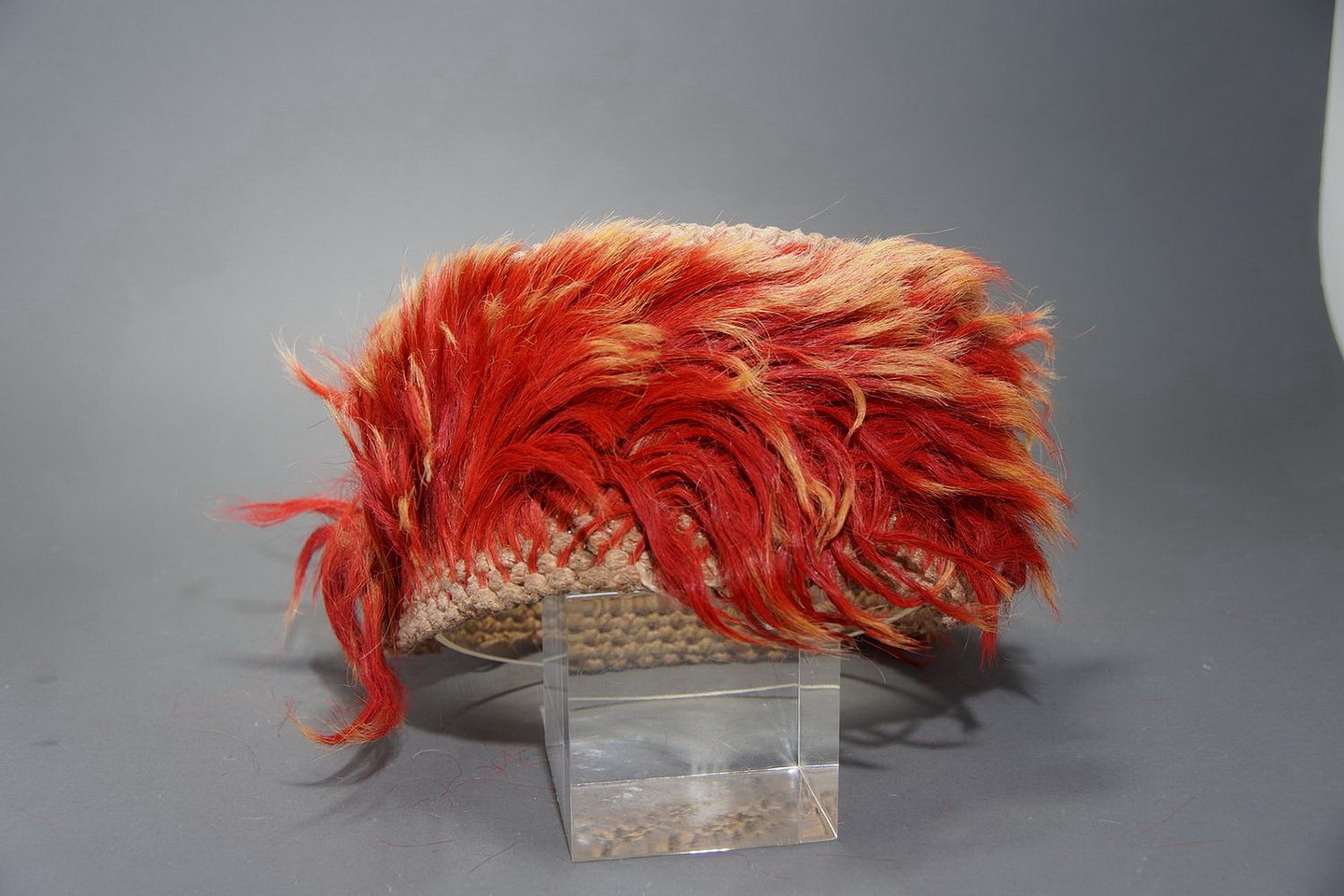




Peru, Nasca Headband with Orange Tie-dye Llama Hair
These unusual headbands are made of a cotton knotted mesh with shanks of llama hair tied into the knots. The inside does not show any of the shanks of hair.
Period: Peru, Nasca valley, South Coast, c. AD 400 - 800
Media: Textile
Dimensions: Diameter 7.5" x Height 4"
Condition: The colors are true without any fade.
Price Upon Request
p1040
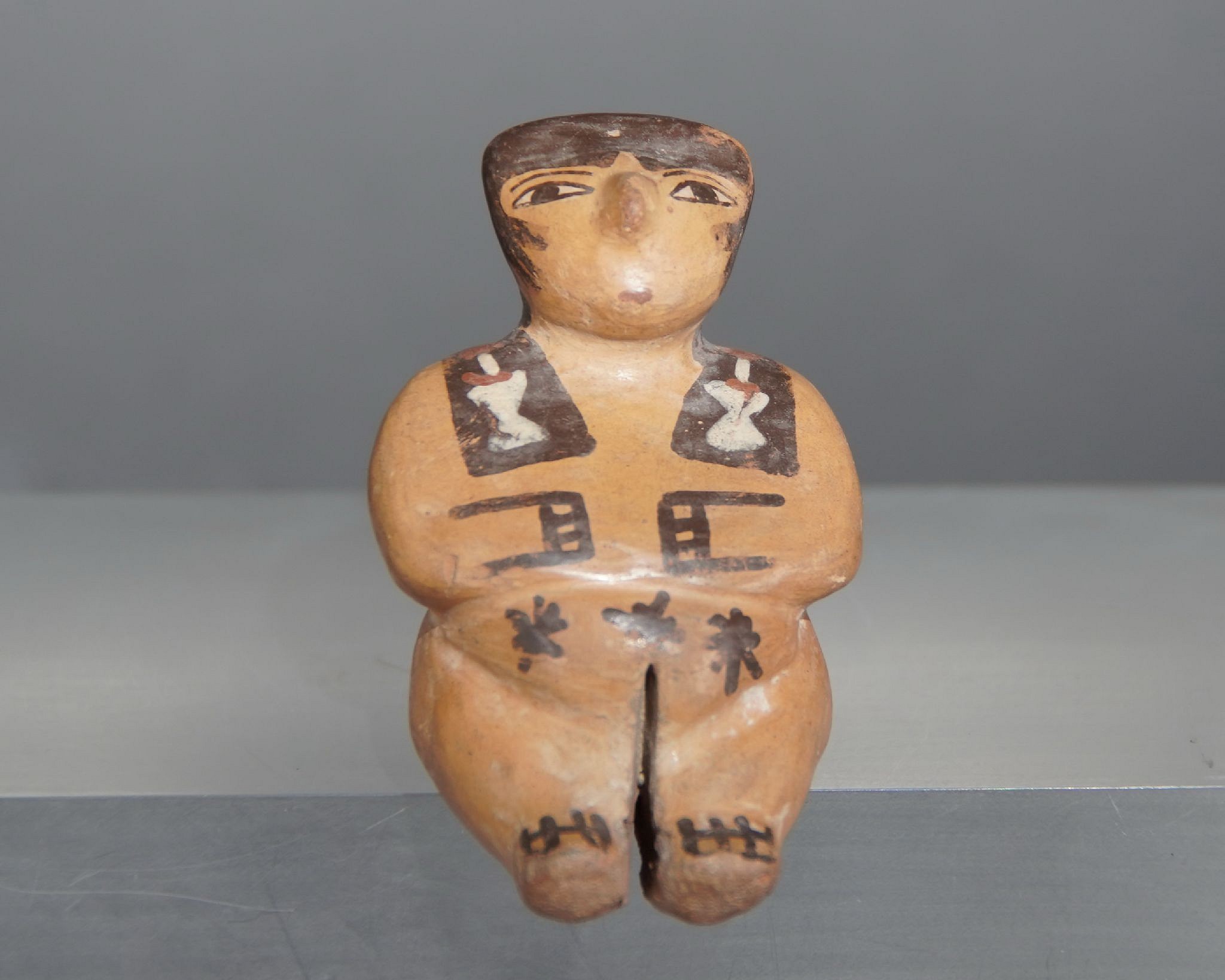





Peru, Nasca Miniature Female Seated Figurine
This seated ceramic female has hands painted on her belly, black hair painted falling over the shoulders, white hair ornaments, and tattoos painted on each buttock. The intricate tattoos depict the San Pedro cactus, which is known to have psychoactive properties. The archaeological record indicates that San Pedro cactus was likely used by the ancient Andeans as a libation during shamanic ceremonies. This figurine would originally have been dressed in a miniature woven garment, which was eroded or lost over time. A similar figure is illustrated in A Sourcebook of Nasca Ceramic Iconography, p. 146. Ex. collection Jean Lions, France.
Period: Peru, Nasca, South Coast, c. AD 400 - 800
Media: Ceramic
Dimensions: Length: 7.1cm
$1,800
M4049






Peru, Nasca Slit Tapestry Band with 8 Faces of The Proliferous Being on Red Ground
All eight faces are in the same orientation and alternate between two color arrangements: those with burgundy faces and those with red-orange faces. Each of the faces has a headdress with extensions, a mouth mask with extensions, and fingers holding a horizontal staff. One of the few Nasca tunics which depicts similar face bands and is same width is illustrated in TEIDOS MILENARIOS - ANCIENT PERUVIAN TEXTILES by Jose De Lavalle, page 264-5, ISBN# 9972-717-01-1.
Period: Peru, Nasca, South Coast, c. AD 400 - 800
Media: Textile
Dimensions: Lengtht: 45 1/2" x Width 6"
Price Upon Request
M6039
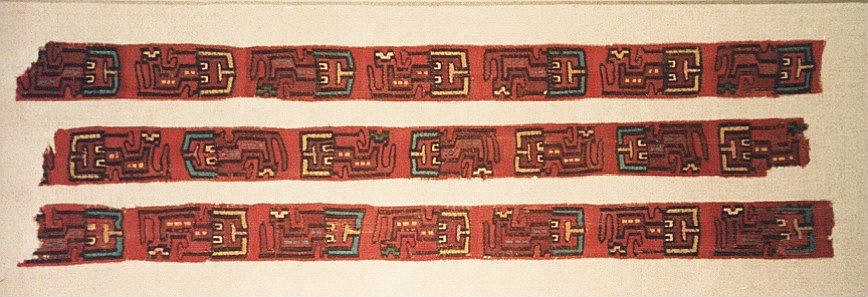


Peru, Nazca Border with 21 Abstract Feline Deities
A Nazca band decorated with seven abstract feline deities alternating in colors blue, yellow and maroon on red ground. The deities face upward, with hind legs and tails outlined in black. When the felines are rotates 90 degrees, they appear to be worms. A similar image is illustrated in Ancient Peruvian Textiles from the Collection of the Textile Museum, plate 17.
Period: Peru, Proto-Nasca, South Coast, c. 100 BC - AD 200
Media: Textile
Dimensions: Length: 20" x Width: 7"
$1,800
94178a
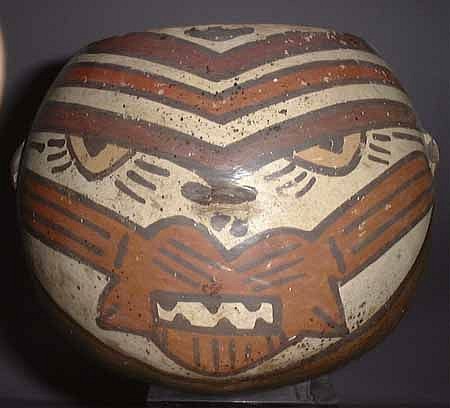
Peru, Nazca Ceramic Bowl with puma head wearing a mouth mask
This large and colorful bowl is decorated with a feline type face wearing a fanged mouth mask with flaring whiskers. The nose, ears and chin are subtly raised. The forehead is decorated with a succession of chevron stripes and the back of the vessel is decorated with two series of semi-circular motifs floating on a band of warm dark brown. The shape of the vessel is globular and the color scheme is maroon, sienna, cream, tan and black. Trophy heads are represented with the most frequency on these vessels. With the exception of foxes, animal portrait masks are seldom represented on this type of vessel. Ceramic vessels with similar masked iconography are featured in "Nasca Geheimnisvolle Zeichen im Alten Peru," Museum Reitberg Zurich, 1999 (exhibition catalog).
Period: Peru, Nasca, South Coast, c. AD 400 - 800
Media: Ceramic
Dimensions: Height 6 1/2" x Diameter 6 1/2"
Price Upon Request
97130





Peru, Nazca lug handled vessel wearing a striped tunic
The figure is wearing a woven read headband and has a painted mustache with bird head decoration for his eyes. He is wearing a colorful stripped tunic with fringe, which is typical for Nazca weaving. This lug handle vessel was made for carrying Chicha or corn beer with a temp line passing through the lug handles so that it could be carried on a person's back.
A similar vessel wearing a tunic is illustrated in CATA PGP DE A CERA OCA MAZCA, by Concepcion Blasco Busqued, 1991, Madrid, pg 94.
Period: Peru, Nasca, c. AD 400 - 800
Media: Ceramic
Dimensions: Height 11" x Width 10"
Price Upon Request
n3042
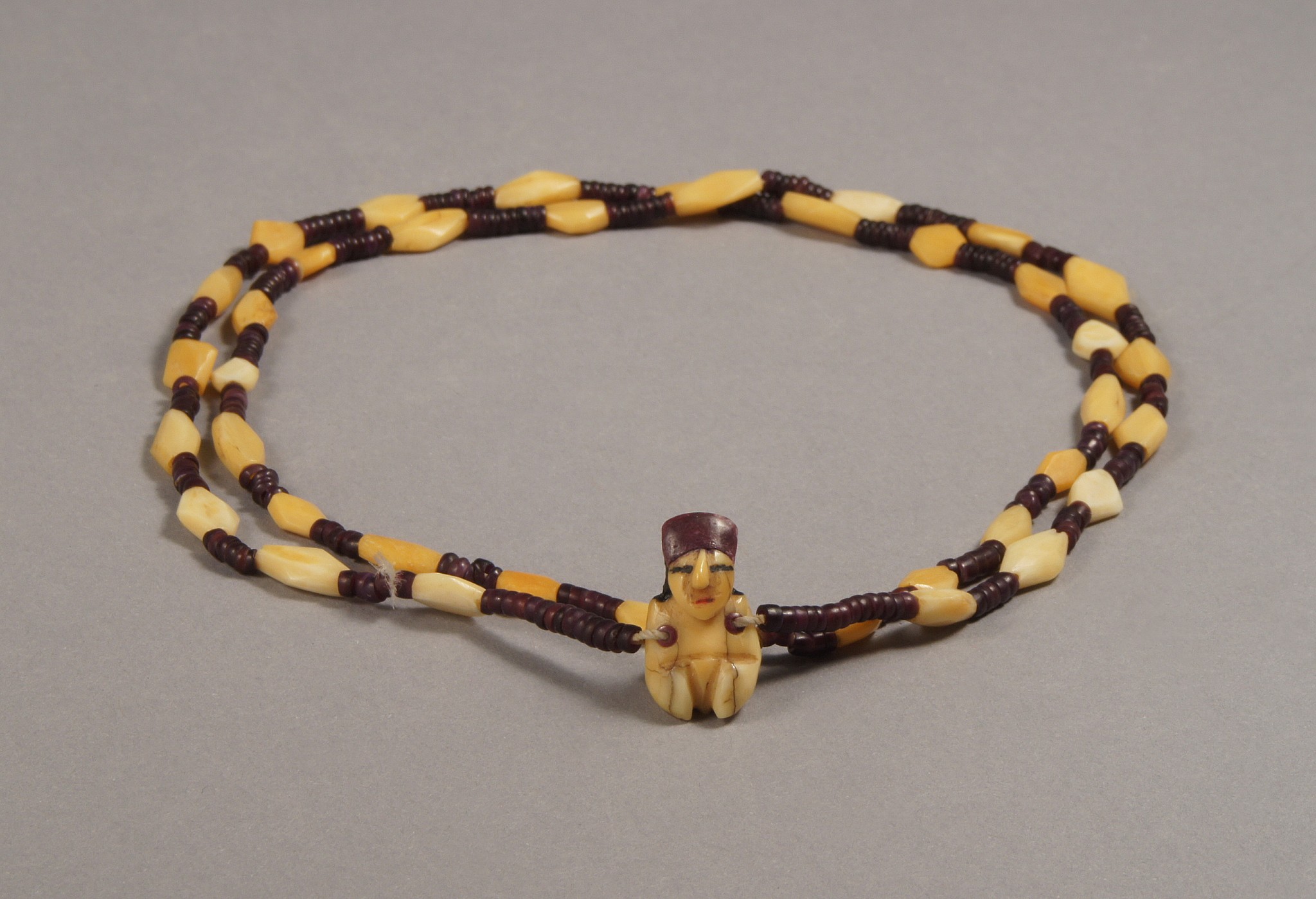





Peru, Nazca necklace with bone and syondylus beads and a minature female pendant
The necklace is made of 32 carved bone beads separated by 6 dark purple circular beads. The pendant is a classic Nazca miniature carved female with traces of painted eyes and mouth. The head piece of purple shell is missing. It's possible that the pendant is made up of Whale tooth ivory. A similar type of figurine is illustrated in 'Miniature Size, Magical Quality - Nasca Art from the Glassell Collection', Marzio, pg 59; and in 'The Inka Empire And Its Andean Origins', Morris and Von Hagen, p.87.
Period: Peru, Nazca, South Coast, circa AD400-700
Media: Bone
Dimensions: Length 68 cm. size of pendant H.1.4cm W. 5cm
$6,500
N1010

Peru, Nazca Polychrome Dish with Serpent Motif
This wonderful Nazca ceramic dish is painted with a spiral serpent motif at the bottom. The serpent is painted with a pattern of white dots. The inner edge of the dish’s high wall is painted with a step-fret pattern in alternating in colors of maroon, white and orange. The step-fret motif likely represents stairs to a temple or stepped agricultural plains, both of which were important to the Nazca. On the outside rim of the dish are 10 painted zoomorphic faces with long noses. The bottom of the dish is painted black. There is evidence of ancient repairs made to the dish, which can be seen via small drill holes made on each side of a crack and binding applied to the crack. Benno Mattel collection, Punta del Este, Uruguay.
Period: Peru, Nasca, Proto Phase, South Coast, c. 100 BC - AD 200
Media: Ceramic
Dimensions: Diameter 9 1/2" x height 2 1/2"
Price Upon Request
N1032
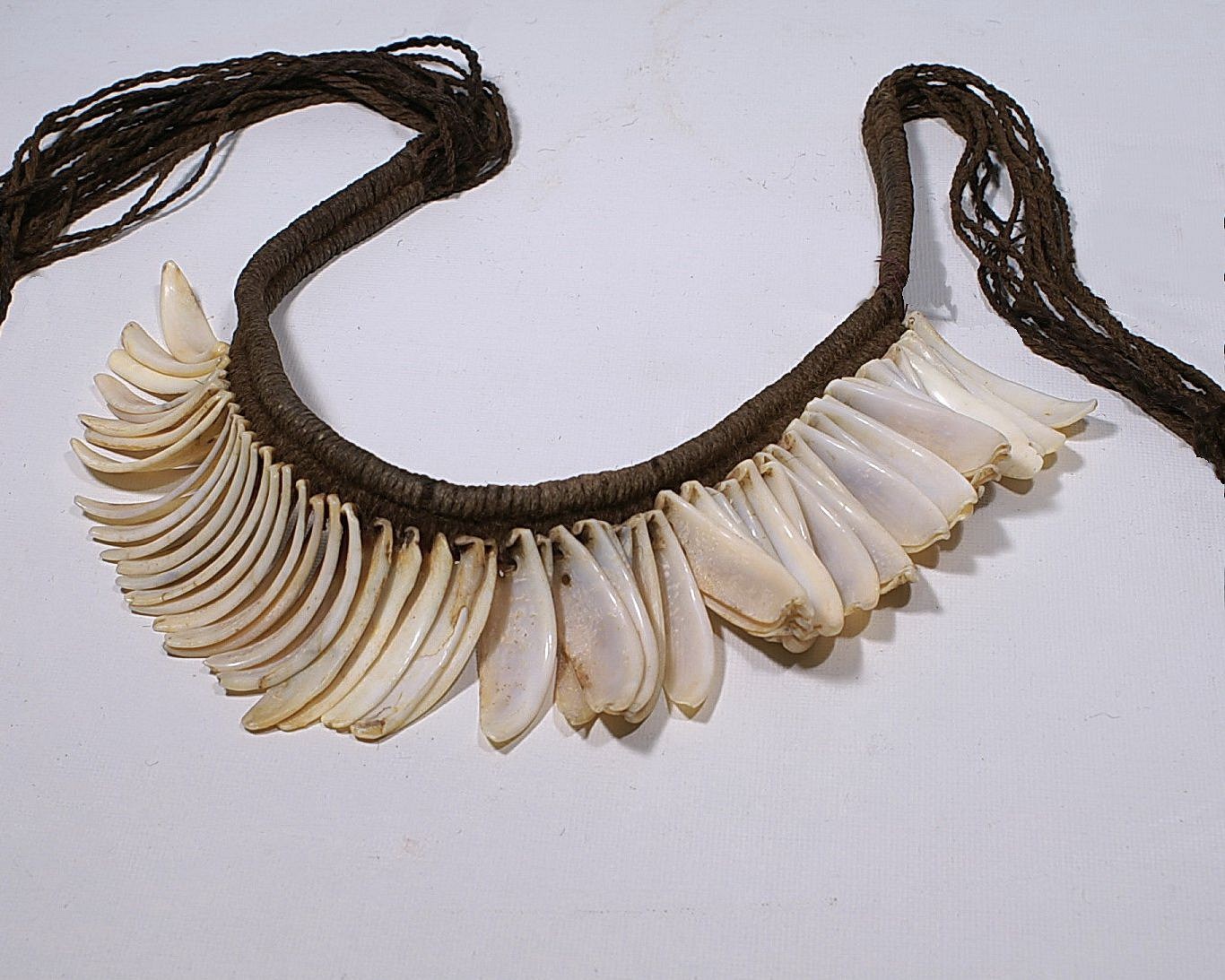




Peru, Nazca shell Necklace on Original Alpaca Cord
It is very rare to find a shell necklace with original stringing intact. This necklace is an excellent example of the Nasca culture's ingenuity in using the local marine resources. Each of the 55 shells is intricately tied to an elaborately knotted foundation cord. The shell appears to be a mussel or razor clam. A similar necklace is in the American Museum of Natural History.
Period: Peru, Nasca, South Coast, c. AD 400 - 800
Media: Shell
$3,200
99177
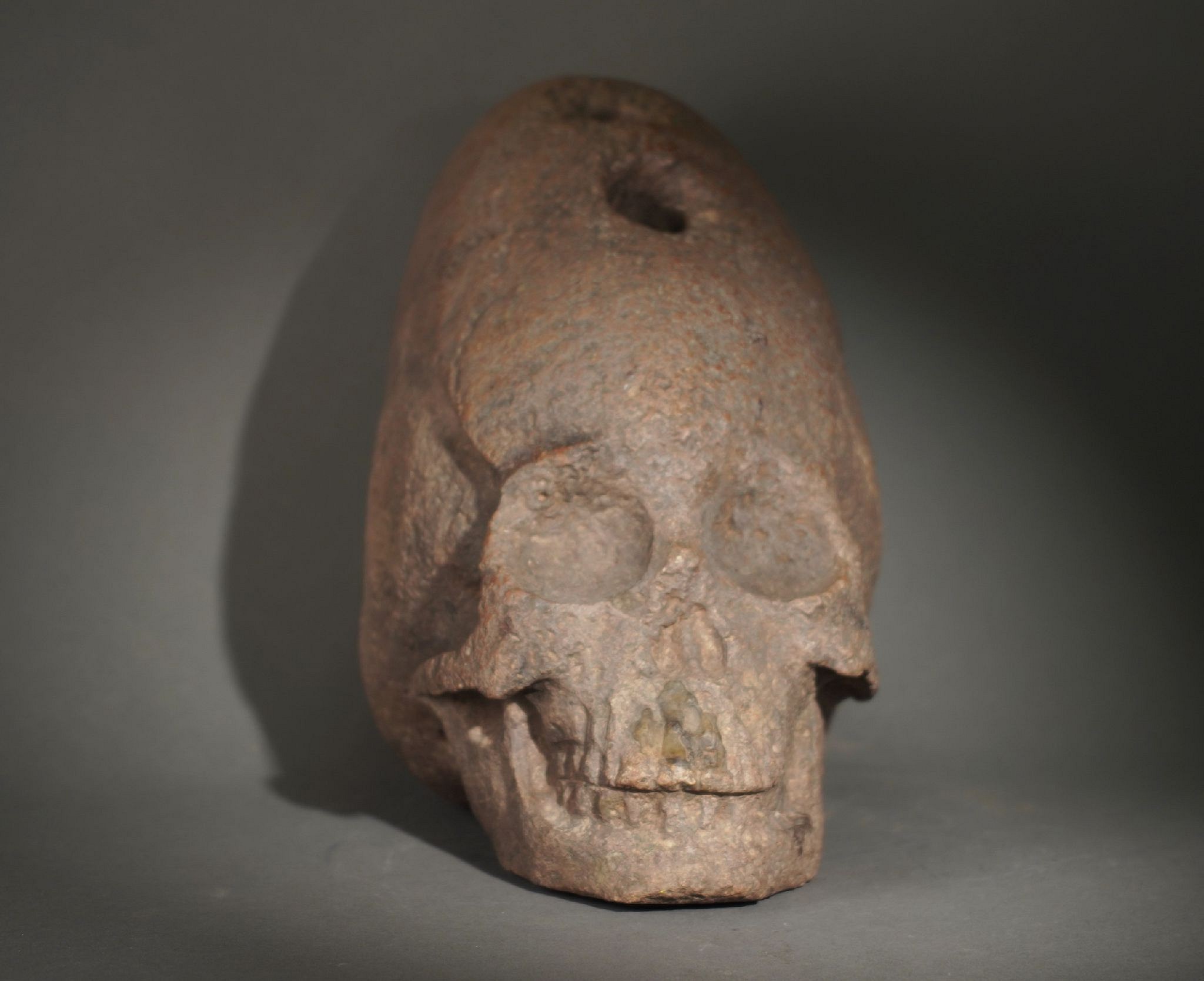
Peru, Official Archaeological Replica of Nasca Elongated Trophy Head
Some Andean cultures including the Paracas and Nasca would keep the skulls of enemy tribal leaders killed in battle as trophies of war. This late 19th century model is an exact replica of an elongated Paracas style trophy head which was dated circa 300 B.C. In keeping with the Paracas style, this trophy head has a set of suspensions holes on top. These holes would have allowed the victorious party to suspend a cord through the two holes for the purpose of displaying the trophy head as a sign of military and spiritual power. The ancient Andeans believed that the victor in battle acquired the spiritual properties of the enemies he killed. Authorized for export by the Peruvian government in 2011, with an official sticker at the base.
Period: Peru, South Coast, Late 19th Century
Media: Stone
Dimensions: Length: 11-1/2" x Height 7- 1/2"
$3,500
p1058
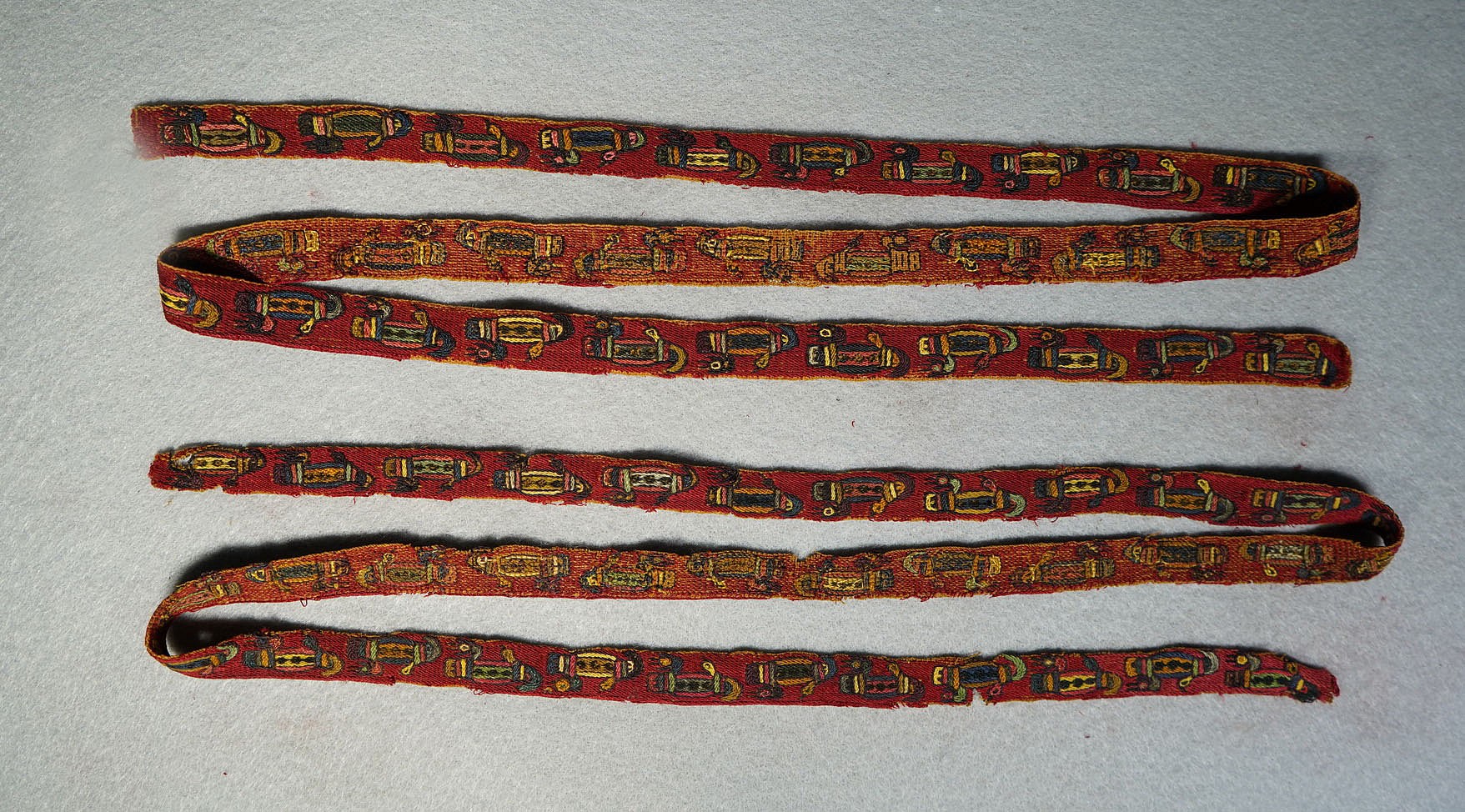




Peru, Pair of Proto Nazca Embroidered Borders with Duck Motif
Weaving technique: embroidery.
These colorful borders to a headpiece were woven with a continuous duck motif in alternating colors on a red ground. When held vertically, the images of ducks appear to be monkeys with faces turned forward, hands held up, and tails curving outward. The weavers used elemental plied wool embroidery, woven with colorful threads through a plain weave of undyed cotton ground fabric. Acquired in 1991 from a California collector prior to the 1980s. Unmounted.
Period: Peru, Proto-Nasca, South Coast, c. 300 - 100 BC
Media: Textile
Dimensions: Lenght: 40" x Width: 12 1/2" each
$2,000
91263
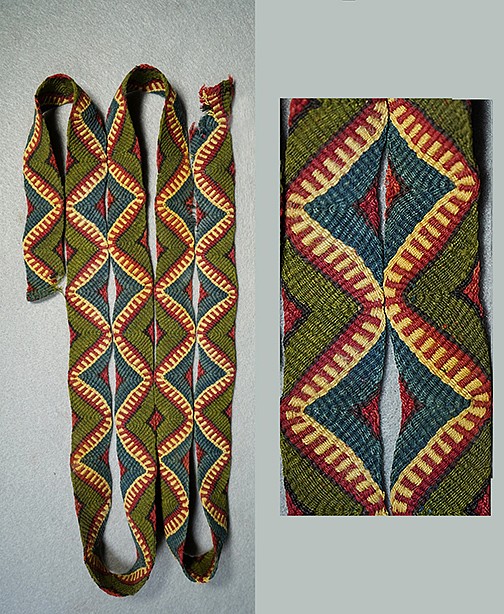





Peru, Paracas Double-woven Plaited Sash
This plaited colorful cloth turban sash is woven with vibrant shades of green, blue, yellow, pink, red, and brown. The triangle pattern when set next to a corresponding triangle creates a rectangle. Acquired in 1999 from a California collector prior to 1980's
Period: Peru, Nasca, Proto Phase, South Coast, c. 100 BC - AD 200
Period: Peru, Nasca, Proto Phase, South Coast, c. 100 BC - AD 200
Media: Textile
Dimensions: Length: 55 inches x Width: 1 inch
$6,500
99511
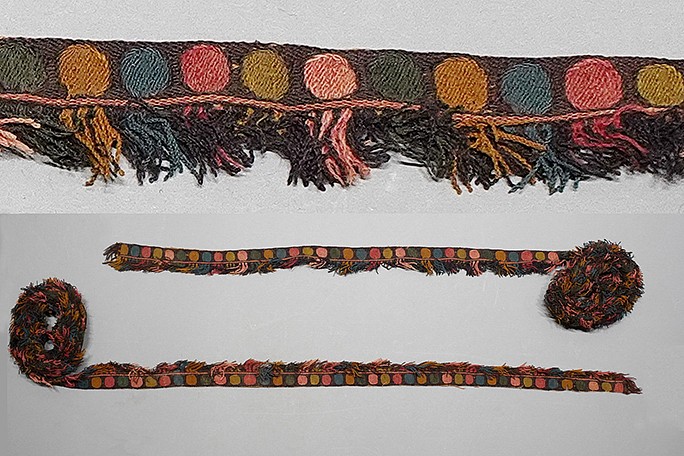


Peru, Paracas Pair of Embroidered Fringes with Alternating Colored Circles
The colored circles repeat in sections of six in blue, green, pinks and gold. All four ends are finished. The outer fringe extension is colored as the same circles. There are 145 circles on each fringe.
Beautiful colors and finished on each end. Unmounted. Private California collection, acquired in 1980.
Period: Peru, Paracas-Ocucaje 10, or Nasca 1, South Coast, c. BC 100 - AD 100
Period: Peru, Paracas-Ocucaje 10, or Nasca 1, South Coast, c. BC 100 - AD 100
Media: Textile
Dimensions: Length:70" X Width: 1" for each fringe.
$4,900
T-20
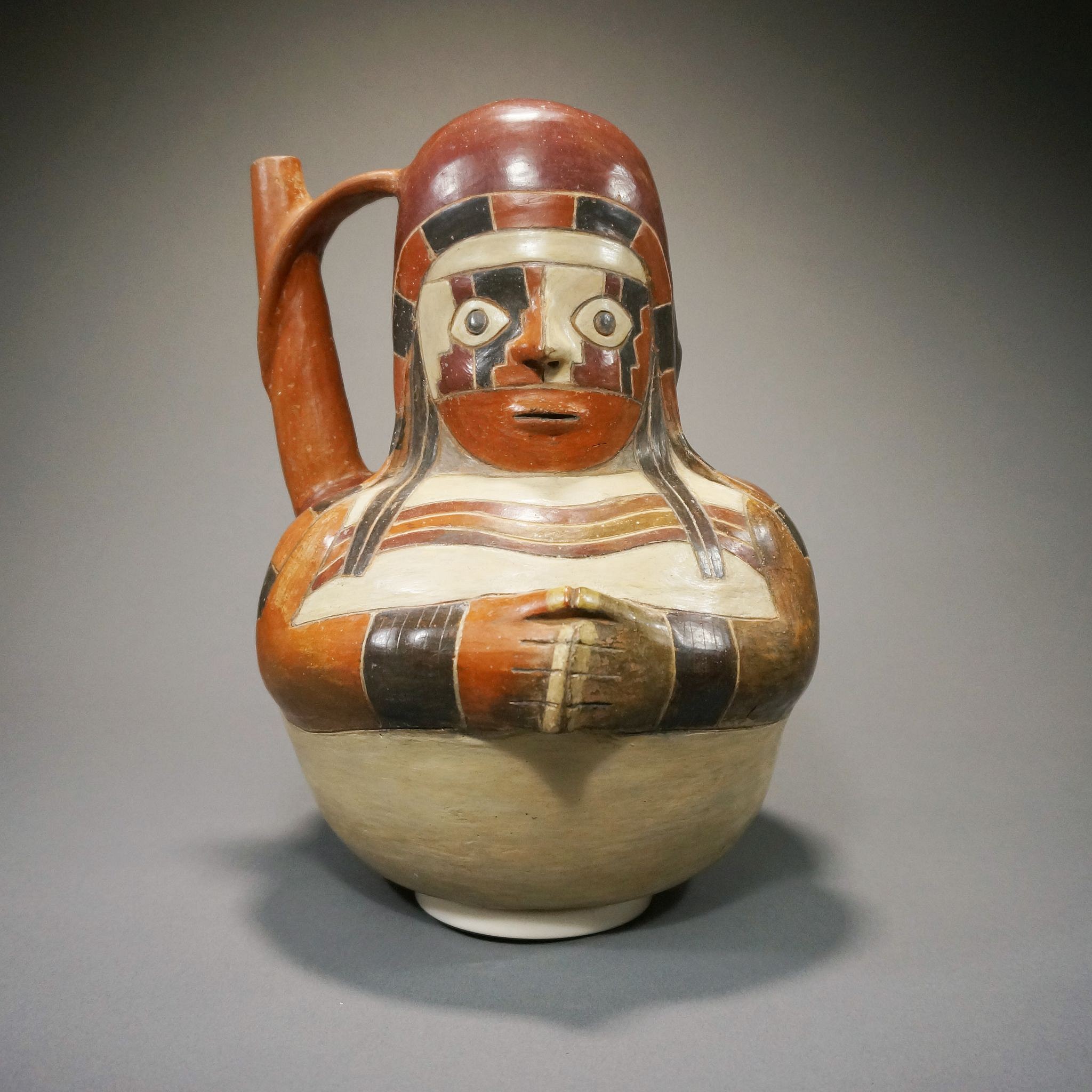
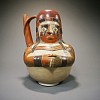


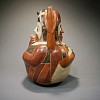
Peru, Proto Nasca Janus Head Effigy of a Smoker
This rare Nasca Janus-headed shaman has two faces, one on either side; both faces depict the same individual who morphs in behavior as the vessel is rotated, telling a narrative story. At the starting side of the narrative, the shaman is smoking a psychoactive plant, possibly tobacco combined with another entheogen. When the vessel is rotated, the same shaman has his face painted and is starring as if he is in a trance. In addition, he is seen wearing an elaborate ritual garb that includes a headdress, a face mask with a step-fret design, and a band of three waved lines across his chest. These garments were not every day utilitarian clothing, and instead indicate a ritual shamanic costume reserved for important ceremonies. The archaeological record indicates that many ancient Andean cultures may have smoked or drank preparations that contained mixtures of tobacco combined with other psychoactive substances. There are very few representations of people smoking in Andean art, but the Spanish chroniclers describe the prevalence of smoking tobacco among the Inca. The early date of this ceramic suggests the use of tobacco in Pre-Columbia as early as AD 100. Acquired in 2004 in Paris. Formerly in the collection of Jean Lions.
Period: Nasca, Proto Phase, South Coast, c. 100 BC - AD 200
Period: Peru, Nasca, Proto Phase, South Coast, c. 100 BC - AD 200
Media: Ceramic
Dimensions: Height: 10 1/4"
$28,000
M4047
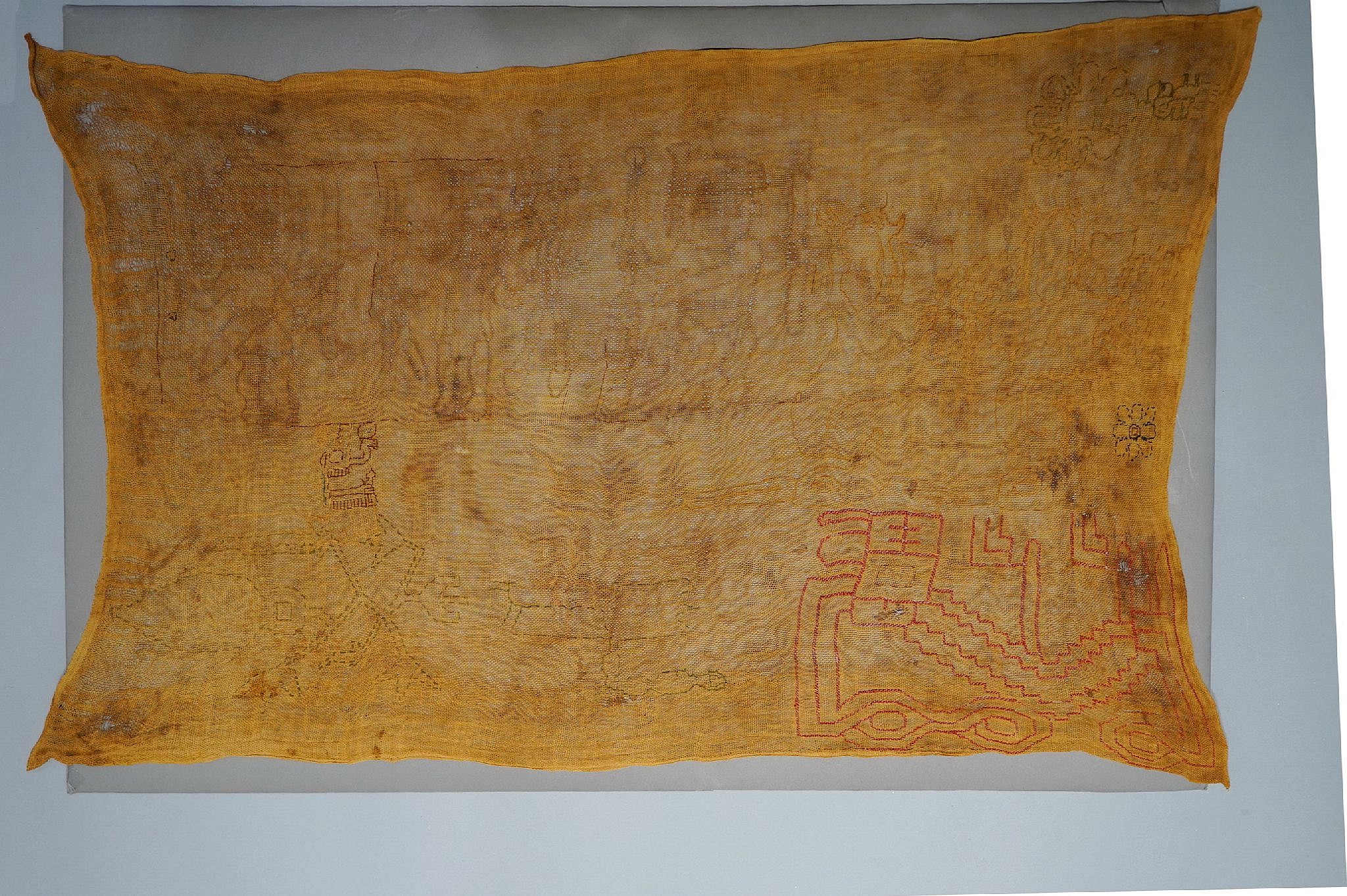








Peru, Proto-Nasca Sampler with Ten Unfinished Images
This intact sampler from the Cabildo site in the upper section of the Rio Grande de Nasca is described by Alan Sawyer in his book EARLY NASCA NEEDLEWORK, published in 1997. The woven backing cloth is complete, but the embroidered figures are still in progress and include partially finished figures and one red serpent. This textile shows how the Nasca craftsmen painted the imagery on the textile first, then outlined each figure with thread, and finally embroidered the imagery. The finished sampler would be double-embroidered with multiple colors and a lexicon of mythological characters and symbols. The book is an excellent reference for study of the richness and complexity of early Nasca imagery. This is a very rare example, as most are in the permanent collections of major museums, including the Art Institute of Chicago, the Metropolitan Museum of Art, New York, and the Textile Museum in Washington D.C. Ex. collection of Nobuko Kajitani, former chief textile conservator at the Metropolitan Museum of Art, prior to 1975.
Period: Peru, Nasca, Proto Phase, South Coast, c. 100 BC - AD 200
Period: Peru, Nasca, Proto Phase, South Coast Calbildo in the Rio de Grande de Nasca, c. 100 BC - AD 200
Media: Textile
Dimensions: Width: 32" x Height: 18"
$11,500
89100
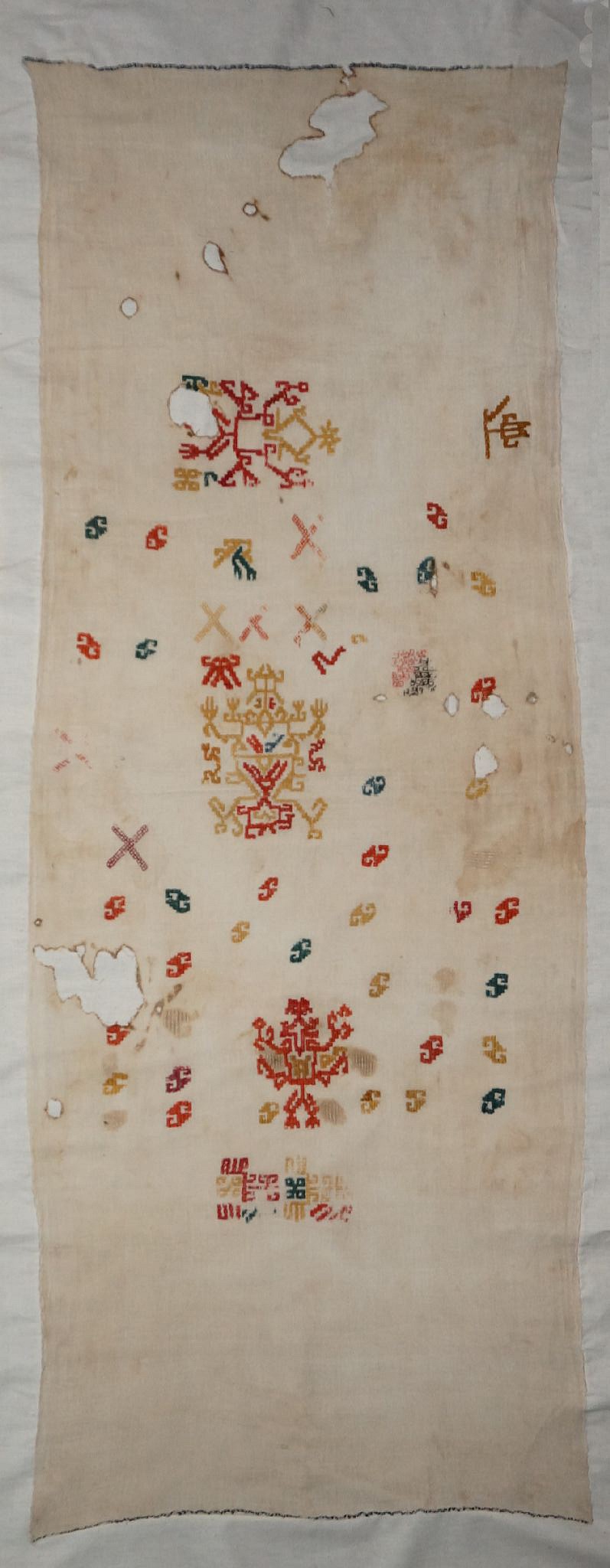



Peru, Proto-Nazca "Cabildo" Sampler with Three Figures in Gold and Red
This sampler is embroidered with abstract creatures with their hands held upwards. The sampler is embroidered with camelid dyed fiber in red, green and gold on a fine woven white cotton ground. The two figures at opposite ends have arms and legs with fancy appendages at the waist and an abstract face on top of each head. Samplers were used by the Paracas and Early Nasca to plan out designs for large textiles. The central figure appeas to be a shaman with a large head wearing a crown with three appendages on each side embroidered in gold. Nested inside the central figure is secondary figure embroidered in red, depicted upside down as if it is falling. The sampler is embellished with 42 individual connected step-volute patterns in red, green, gold and brown. In addition, there are five X's interspersed in the design. The panel is complete, in good condition, with all sides selvaged, and professionally lined. There are 3 small holes and 7 very small holes. Similar samplers are discussed and illustrated in "Early Nazca Needlework" by Alan Sawyer.
Period: Peru, Paracas, Ocucaje-South Coast , 300 - 200 BC
Period: Peru, Cabildo, South Coast, c. AD100 - 200
Media: Textile
Dimensions: Length: 63" x Width: 22"
$6,500
93129
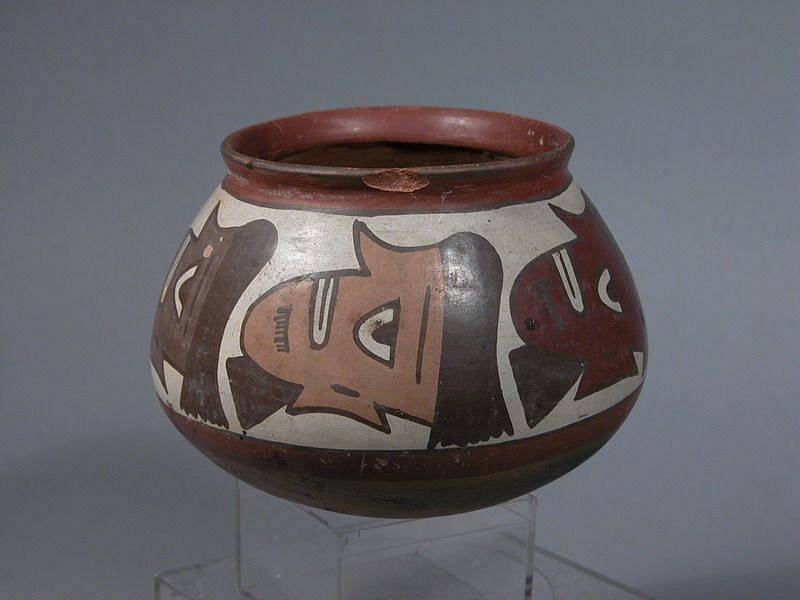




Peru, Small Nasca Bowl with Painted Trophy Heads
The trophy heads are in profile and alternating in red, grey and beige on a cream ground. Trophy head paintings by the same artist are in the Volkunde Museum in Berlin and are illustrated in ALTPERUANINISCHE KULTUREN –NAZCA II, in figures 120 & 121. Ex. collection Hans Monheim, Achen Germany.
Period: Peru, Nasca, South Coast, c. AD 400 - 800
Media: Ceramic
Dimensions: Height 3 3/4" x Diameter 3 3/8cm
Price Upon Request
M4035
























